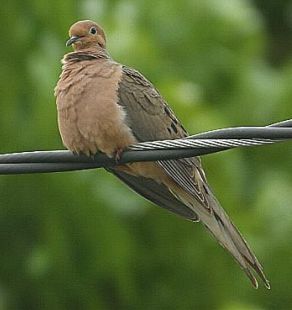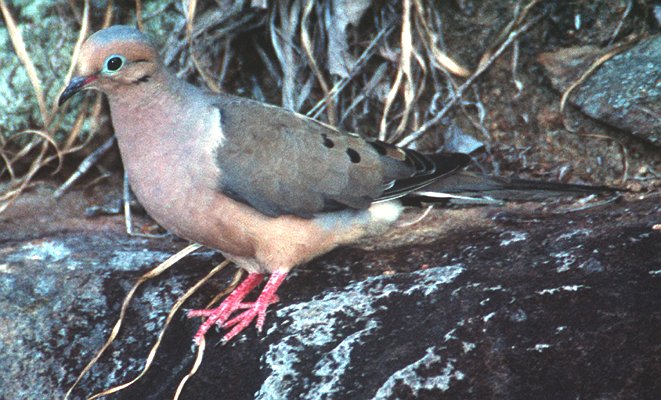|
Mourning Dove Zenaida macroura Tórtola Rabilarga,
|
 |
|
Photo: A. Sánchez Muñoz
|
|
Mourning Dove Zenaida macroura Tórtola Rabilarga,
|
 |
|
Photo: A. Sánchez Muñoz
|
|
IDENTIFICATION: A medium-sized dove with a long, pointed tail, especially obvious in flight. It lacks the white wing patches and deeper reddish hues of the Zenaida Dove. Length: 23-34 cm., with males tending to be longer; weight: 108 g. VOICE: The song is a series of cooing notes, very similar to the Zenaida Dove’s song, but usually with a slower, prolonged ending. The Dove’s English name reflects the "sad" quality of the song. The wings whistle on take off. Audio 3 (M. Oberle). HABITAT: Open country with occasional trees, especially near agricultural fields or farmyards with spilled grain. HABITS: Feeds almost exclusively on the ground where it bobs its head as it walks in search of plant seeds and waste grain in fields. It typically flies to a pond or open puddle in the morning and late in the afternoon to quickly drink. As breeding season approaches, the Mourning Dove establishes monogamous pairs. Mates preen each other’s feathers (allopreening), and the male performs a circling display flight, with wings held stiffly downward. The male brings nest material to the female and stands on her back as he hands off each twig. The female weaves a crude nest platform in a tree fork, and lays two white eggs in a clutch. Both sexes incubate the eggs over a 13-14 day period, with the female preferring to incubate at night. After the eggs hatch, the parents feed the chicks "pigeons’ milk" produced by their crop, for the first 4-5 days, and then gradually add seeds to the chicks’ diet. The parents brood the young almost constantly for the first 4-5 days after hatching. Only 12-14 days after hatching, the young are ready to fly. Adults may raise additional broods later in the season. In July after nesting is completed, this species forms feeding flocks of dozens or hundreds of birds. STATUS AND CONSERVATION: A common, local species, especially near agricultural fields in the southwest. It expanded its range into Puerto Rico and Vieques in the 20th Century, and is now common enough that it is one of four species of doves legally hunted (in most years, from September to November). This species is particularly susceptible to lead poisoning after eating lead shotgun pellets that it finds on the ground. The reduction in agricultural land in Puerto Rico due to urban sprawl may eventually reduce this species’ population locally. RANGE: Breeds from southern Canada south to southern Mexico, as well as in the Bahamas and Greater Antilles. In winter, some North American breeders migrate as far south as Costa Rica. Regular locations to find this species are in the open fields near Laguna Cartagena National Wildlife Refuge and Caño Tiburones Nature Reserve. TAXONOMY: COLUMBIFORMES; COLUMBIDAE |
|
 |
|
Photo: G. Beaton
|
 |
|
Photo: G. Beaton
|
|
References Bent, A.C. 1938. Life histories of North American gallinaceous birds. Smithsonian Instit. U.S. National Museum Bull. 162. (Reprinted by Dover Press, NY, 1963). del Hoyo, J., A. Elliott, and J. Sargatal, eds. 1998. Handbook of Birds of the World, Vol. 4. Sandgrouse to cuckoos. Lynx Edicions, Barcelona. Gibbs, D., E. Barnes, and J. Cox. 2001. Pigeons and doves: A guide to the pigeons and doves of the world. Yale University Press. Johnson, K. P., S. de Kort, K. Dinwoodey, A. C. Mateman, C. ten Cate, C. M. Lessells, and D. H. Clayton. 2001. A molecular phylogeny of the dove genera Streptopelia and Columba. Auk. 118(4):874-887. Mirarchi, R. E. and T. S. Baskett. 1994. Mourning Dove (Zenaida macroura). No. 117 in The birds of North America (A. Poole and F. Gill, eds.). Acad. Nat. Sci., Philadelphia, PA, and Am. Ornithol. Union, Washington, D.C. Ortiz Rosas, P. 1981. Guía del cazador: aves de caza y especies protegidas. Depto. de Recursos Naturales, San Juan, PR. Raffaele, H.A. 1989. A guide to the birds of Puerto Rico and the Virgin Islands. Princeton. Raffaele, H.A. 1989. Una guía a las aves de Puerto Rico y las Islas Vírgenes. Publishing Resources, Inc., Santurce, PR. Raffaele, H.A., J.W. Wiley, O.H. Garrido, A.R. Keith, and J.I. Raffaele. 1998. Guide to the birds of the West Indies. Princeton. Rivera-Milán, F.F. 1992. Distribution and abundance patterns of columbids in Puerto Rico. Condor 94:224-238. Rivera Milán, F. F. 2001. Transect surveys of columbid nests on Puerto Rico, Vieques, and Culebra islands. Condor 103:332-342. Saliva, J.E. 1994. Vieques y su fauna: Vieques wildlife manual. U.S. Fish & Wildlife Service, Boquerón, PR. Sorrie, B.A. 1975. Observations on the birds of Vieques Island, Puerto Rico. Carib. J. Sci. 15:89-103. Next related species in taxonomic order Previous related species in taxonomic order |
|